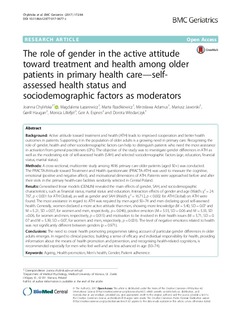| dc.description.abstract | Background: Active attitude toward treatment and health (ATH) leads to improved cooperation and better health outcomes in patients. Supporting it in the population of older adults is a growing need in primary care. Recognising the role of gender, health and other sociodemographic factors can help to distinguish patients who need the most assistance in activation from general practitioners (GPs). The objective of the study was to investigate gender differences in ATH as well as the moderating role of self-assessed health (SAH) and selected sociodemographic factors (age, education, financial status, marital status). Methods: A cross-sectional, multicentre study among 4936 primary care older patients (aged 50+) was conducted. The PRACTA-Attitude toward Treatment and Health questionnaire (PRACTA-ATH) was used to measure the cognitive, emotional (positive and negative affect), and motivational dimensions of ATH. Patients were approached before and after their visits in the primary health-care facilities randomly selected in Central Poland. Results: Generalised linear models (GENLIN) revealed the main effects of gender, SAH, and sociodemographic characteristics, such as financial status, marital status and education. Interaction effects of gender and age (Wald’s χ2 = 24.767, p < 0.001 for ATH Global), as well as gender and SAH (Wald’s χ2 = 16.712, p < 0.002 for ATH Global) on ATH were found. The most assistance in regard to ATH was required by men aged 50–74 and men declaring good self-assessed health. Generally, women declared a more active attitude than men, showing more knowledge (M = 5.40, SD = 0.07 and M = 5.21, SD = 0.07, for women and men, respectively, p = 0.046), positive emotion (M = 5.55, SD = 0.06 and M = 5.33, SD =0.06, for women and men, respectively, p = 0.015) and motivation to be involved in their health issues (M = 5.71, SD = 0.07 and M = 5.39, SD = 0.07, for women and men, respectively, p = 0.001). The level of negative emotions related to health was not significantly different between genders (p = 0.971). Conclusions: The need to create health promoting programmes taking account of particular gender differences in older adults emerges. In regard to clinical practice, building a sense of efficacy and individual responsibility for health, providing information about the means of health promotion and prevention, and recognising health-related cognitions, is recommended especially for men who feel well and are less advanced in age (50–74). | nb_NO |
| dc.description.localcode | © The Author(s) 2017. This article is distributed under the terms of the Creative Commons Attribution 4.0 International License (http://creativecommons.org/licenses/by/4.0/), which permits unrestricted use, distribution, and reproduction in any medium, provided you give appropriate credit to the original author(s) and the source, provide a link to the Creative Commons license, and indicate if changes were made. The Creative Commons Public Domain Dedication waiver (http://creativecommons.org/publicdomain/zero/1.0/) applies to the data made available in this article, unless otherwise stated. | nb_NO |

